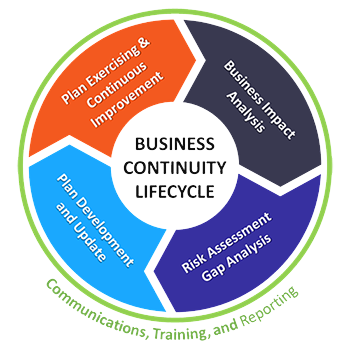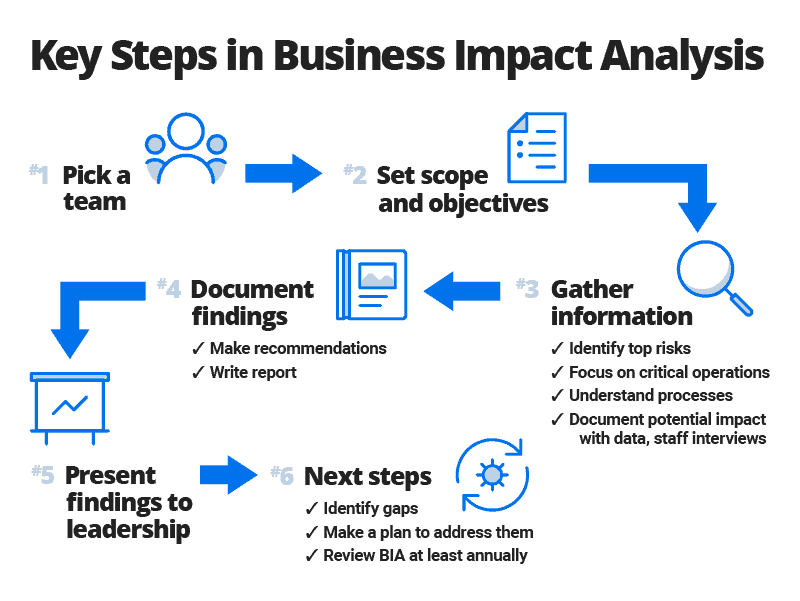
UC Ready Business Continuity
UC Riverside Continuity Planners collaborate with faculty & staff to increase the University’s resilience in the face of disruptive events. By building resilience, these dedicated planners work to improve the ability to continue the University’s mission of teaching, research, public service, and patient care during any disruptive event - and to return to normal performance as quickly as possible. An important aspect of this work is the development of a continuity plan for the institution as a whole, as well as for select individual departments. These mission continuity plans contain information and strategies that would be needed during a recovery process, as well as recommendations for advance preparations.
The provision of UCR's Business Continuity program begins with training and awareness in which end users are educated on the Business Continuity Life Cycle, which occurs on an annual basis. This life cycle is comprised of the following phases:
UC Ready Software Tool
Activating a UCReady account enables access to the planning software guided, step-by-step process to create a continuity plan that:
Define Priorities: What are operational priorities? This process develops a business impact analysis (BIA) that is created via the Essential Function and Application questions of UC Ready.
Identifies Recovery Strategies: Based on the priorities and risks that we have identified, we then identify strategies for continuing our operations (e.g. working remotely, reciprocal agreements, etc.). Strategies your department may have identified previously have been transitioned over to the upgraded version of UC Ready.
What is Business Continuity?
A business continuity plan goes into action after the emergency management team stabilizes campus life and safety and is implemented to help departments continue operations. These plans also work with IT disaster recovery plans and procedures to restore IT services (e.g., applications and infrastructure) as part of the overall campus business continuity plan.
Select a tab below for specific details for sections of continuity planning:
The Business Impact Analysis is a collaborative data collection activity. Interviews are conducted with the functional owners and administrators of a business function to understand:
- Services provided by the business function.
- Dependencies that the business function has in order to operate (i.e., facility, people, technology, vendor).
- Recovery requirements of dependencies.
- Alternatives, workarounds, and/or manual processes in the event the dependencies is unavailable or inaccessible.
- Potential risk impact that the University could experience in the event the business function could not recover and establish continuity within their recovery objective(s).
- Business Impact Analysis data is housed and maintained within the Business Function tab of the Fusion Framework.
The Risk Assessment and Gap Analysis consolidates the results of the Business Impact Analysis by prioritizing dependencies based on the criticality of their recovery objectives, and conducting a comparison against current recovery capabilities to determine if a potential recovery gap is present. These results are presented to organizational leadership to review and decide if the potential gap is an acceptable risk or if it should be remediated through additional investments or workarounds. This analysis enables:
- Senior and functional leaders within a campus organization/division collaborate to understand the potential risks that could impact operational continuity in the event of a disaster or significant disruption.
- Transparency between campus entities to identify recovery requirements and dependency recovery capabilities.
- Thoughtful risk management and informed decision making.
- Facilitation of conversations between campus leaders and dependency providers to determine effective solutions for risk remediation.
UCR continuity plans proactively focus on mitigating potential impacts and how to stay operational during a disruption. Business Continuity Planning documents the actions and activities that a business function will execute to establish and sustain continuity of operations at an acceptable level within recovery objective(s) in the event of a disaster or significant business disruption. Plans are designed on an all-hazard approach focusing on four key loss scenarios:
-
Loss of Facility
-
Loss of People
-
Loss of Supplier
-
Loss of Technology
An all-hazard approach focuses on the impact of a loss as opposed to the cause. Business Continuity Plans are developed and maintained within the Fusion Framework.
Plan Exercising and Continuous Improvement validates the feasibility of a Plan, identifying opportunities for continuous improvement over time. Exercises can take the form of a simulated event or a live event. A live event is a situation in which the Business Continuity Plan was used in an actual disaster or significant business disruption to the business function. A simulated event is facilitated by DR/BC Services where a business function can exercise a Business Continuity Plan in one of the three ways:
-
Walkthrough – a gathering of the business function team to conduct a detailed review of the Business Continuity Plan, ensuring awareness and understanding of content, roles, and responsibilities
-
Tabletop – a gathering of the business function team to discuss and role play a disaster or significant business disruption for the purpose of exercising the Business Continuity Plan in a controlled environment
-
Functional – a gathering of the business function team to perform and role play a disaster or significant business disruption for the purpose of exercising the Business Continuity Plan in as real of an environment as possible without an actual disaster or significant business disruption occurring
Exercise information and results are maintained within the Fusion Framework.
UCR’s ability to remain operational following a disruption is dependent upon its ability to maintain our core mission serving our students, faculty, staff and the community and is one of the integral parts of the comprehensive emergency management paradigm under the Recovery phase.



